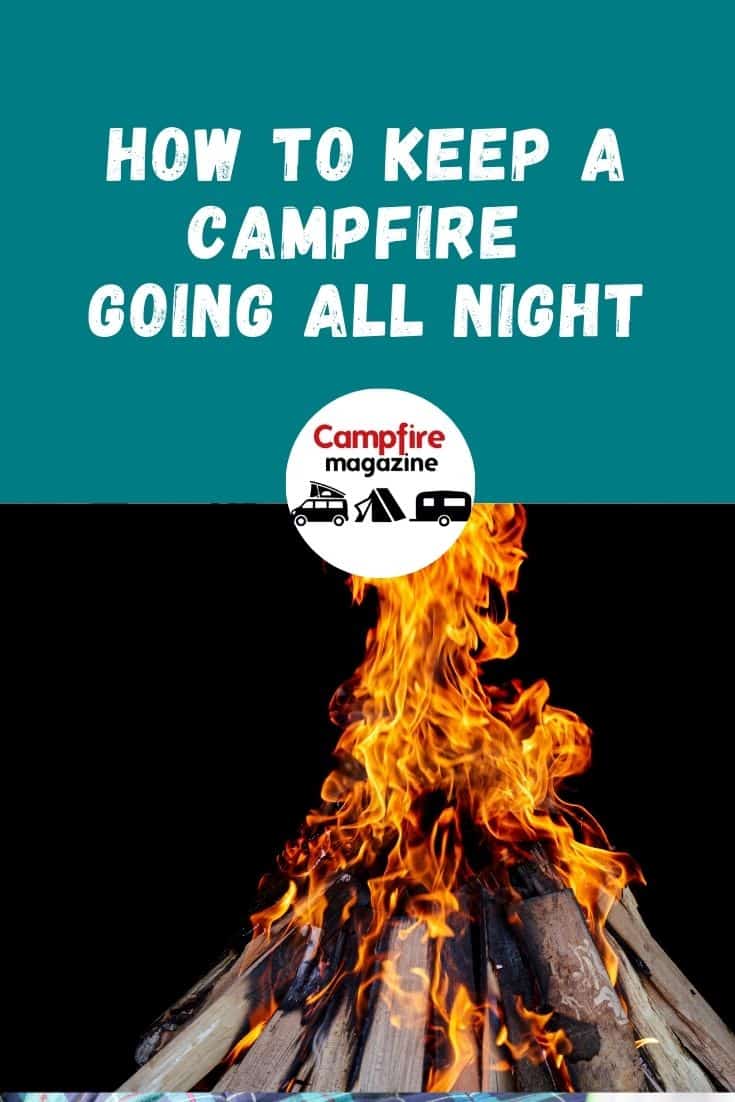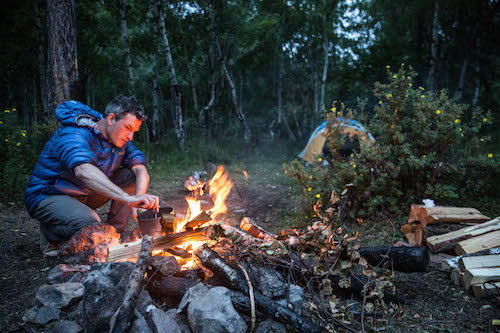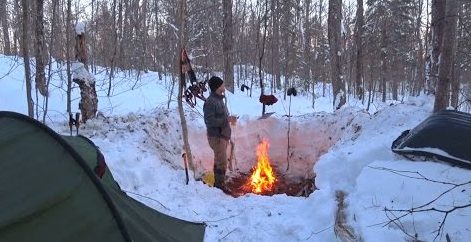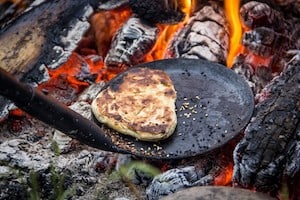Learn how to keep a campfire going all night with our quick and simple guide to preparing, building and tending your fire.
Keeping a campfire burning all night requires a steady supply of heat, oxygen, and fuel. You can provide this by using the right materials including suitable wood types, building your fire carefully with a slow-burning campfire lay, and tending it as needed.
If you enjoy camping in the wilderness, you may sometimes need to build an overnight campfire. This article tells you how you can build a steady, sustainable and safe campfire which will burn as long as you need. We also look at some of the best and worst campfire materials, what you can do if it rains, and how to fully extinguish your campfire in the morning.

Why would someone need a campfire to burn all night?
There are a number of reasons why you might want your campfire to burn all night, especially if you’re camping out in the wilderness and far from civilization. A steadily burning campfire provides the following potential benefits:
- Warmth: temperatures can drop significantly in some geographies when the sun goes down, even if the day has been warm.
- Protection: fire is intimidating to wild animals and can help to keep them away from your campsite.
- Light: a campfire can provide light if you need to keep watch, or will be staying up all night for any other reason.
- Cooking: an all-night campfire can slowly cook your breakfast overnight
- Signaling: if you are lost, or if you’re waiting for another camping party to catch up with you, a campfire may be seen from some distance and help others to find you.

Is it safe to keep a campfire burning all night?
The answer to this question will depend on the wider circumstances, the type of fire, exactly where you are camping, and whether anyone will be awake to monitor the fire.
If you’re out in the wilderness, in very cold weather, with a variety of dangerous local wildlife in the vicinity, it may be safer to keep a campfire burning all night than not.
If you’re in a national park at the height of a dry summer, in a US state or country with a history of wildfires, and planning to go to sleep, it is certainly not safe to keep your campfire going all night. Follow relevant local rules and guidance around campfires (e.g. the USDA Forest Service fire restriction in the USA) to keep yourself and others safe.
What materials do I need for a campfire that will burn all night?
The materials you need for a long-burning campfire are largely the same as for any fire. You should prepare all your materials in advance and keep them dry and close to hand once you begin setting your fire.
Be aware that if you’re in a national park, you may be allowed campfires only within designated areas and/or in steel-lined pits provided. In other areas, you may need to prepare your own fire pit with a cleared area around it to contain the campfire. Make sure you know any local fire restrictions before you begin.
A fire starter
You will need some means of producing a flame or spark to begin your campfire. A lighter, matches, flint and knife, or fire drill and platform, could all be used depending on circumstances and tools available.
Tinder
To get a campfire going you will also need tinder, a term for material that readily catches fire with a spark or small flame. Wood shavings, cotton balls, dried grasses, cattail fluff and dry birch bark are all examples of good tinder materials.
Kindling
Kindling materials will burn once a flame is present and are used to keep the fire going long enough for other fuel sources to catch fire. Dried leaves and twigs, small sticks, twisted newspaper, pine cones and candles all make good kindling. We wrote an article regarding the difference between tinder and kindling.
Wood
The main fuel of your campfire will be wood. Wherever possible this should be dry, split into pieces of the right size for the fire you’re setting, and of a slow-burning wood variety (e.g. oak, ash) if you want your campfire to continue all night.
Optional materials
You can add a few rocks inside the heart of your fire to help keep it going all night. Rock is good at holding and conducting heat and will help maintain a steady high temperature inside the fire as the fuel burns. Rocks can also create small spaces for air between the ashes and pieces of wood, allowing a steady flow of oxygen to maintain the fire.

How do I lay a campfire that will burn all night?
Structuring and building your campfire are key to how long it’s likely to keep burning. There are many different campfire lays (methods of setting up a campfire before lighting) and some are are better suited to long burning than others.
There are some common general principles to remember. For example, fire needs air, so a dense stack of wood without any air gaps will not easily catch light. Most bark burns slower than inner wood, so for kindling it’s best to split wood into smaller pieces with the inside exposed.
A simple fire can be started by laying a few larger pieces of wood at the base of your campfire, placing a good supply of tinder at the base, and building a cross-hatched tower of further pieces of wood above this, with kindling placed in the gaps between the larger pieces of wood.
A match, lighter or spark to the tinder, perhaps with a breath or two to fan the flame, should cause the tinder and kindling to catch light, setting fire to the larger pieces of wood.
Traditional “log cabin” or “platform” type campfire lays are better known and straightforward to build but variants such as the “star” may provide longer burning. A ramped self-feeding campfire structure takes more time and preparation to set up but can then fuel itself all night without further intervention. If you have access to a chainsaw, you could even set up a “Swedish candle” campfire.
How do I keep a campfire burning all night?
There are three main options for keeping a campfire burning all night:
- someone stays up all night adding wood to the fire as needed,
- you structure the campfire in such a way that it’s self feeding, with more wood falling into the flames as pieces are consumed,
- you choose woods and campfire lays which are long-burning by design, adding rocks and/or air channels to maintain heat and give a steady controlled oxygen flow at the centre of the campfire.
What do I do if my campfire starts dying down?
If your campfire shows signs of dampening down, it might need more fuel or more oxygen. Check that there is enough wood in the fire to keep it burning, and also that it’s arranged in a way which allows all the pieces to burn.
To ensure a sufficient airflow carrying oxygen to the fire, make sure there are gaps between the pieces of wood. You can use rocks to create spaces when you lay your fire. You can also dig trenches to ventilate your fire, which can be a useful technique with larger campfires.

Check out our Fire Pit Cooking article
Can I keep my campfire burning in the rain?
There are many ways in which weather can affect the way a campfire burns. One of the greatest weather challenges will be keeping a fire burning when it rains. We recently wrote an article regarding how long does it take for wood to dry after it rains.
You should obviously check the weather before setting off on any camping trip and make sure you are prepared for likely local conditions. If you know there’s a chance of needing to start a fire in rainy or damp conditions, you might want to carry some chemical firelighters, a candle, cotton or newspaper coated in vaseline or melted paraffin.
If you’re carrying wood in a pack, car boot or van, make sure it stays dry undercover until it’s needed. When building up the fire, work under a tarp or other shelter to keep the wood, tinder and kindling dry until you light it.
If rain takes you by surprise and you need to find wood for your fire, there are a couple of steps you can take even in wet weather. For example, as long as you have tools, you can split logs and large pieces of wood to get to their dry center. Hack or shave off pieces of the dry core with an axe, saw or knife to build your fire.
You might also usefully search for pine, spruce or fir trees which have a resinous, flammable and water-impervious sap. These trees, especially the stumps, are a good source of “fat lighter”, wood which is saturated in pitch or resin sap. When added to a campfire, this fat lighter is excellent tinder or kindling and can help keep the fire burning even in wet weather.
What are the best and worst materials for a long-lasting campfire?
Some woods burn slower than others and for an all-night campfire slow-burning woods are best. You should consider ash, oak, maple, cherry, birch or beech.
Wet wood of any sort is a bad campfire choice if you can avoid it. If you have no choice, you should aim to use tools to split the wet wood and try to build a fire with the dry inner sections.
Newspaper, wood shavings and dry twigs are all useful for starting a quick fire but will not sustain it over long periods. You will need to add thicker, slower-burning wood or other fuel to keep a campfire fire burning after the initial blaze.
How long does it take for a campfire to burn out?
A campfire will be burned out when its fuel source is completely consumed and there is no wood remaining to burn. At this stage, there will still be hot embers at the base of the fire which could ignite more wood or other flammable material if these are added, or could flare up in the wind and be blown onto flammable areas of woodland.
The embers will slowly and gradually cool down in the air. If you let this happen naturally, it could take 12-24 hours until the fire site is completely burnt out and cool to the touch. If you don’t have this much time, you should extinguish the campfire fully before leaving the site.
How to keep a campfire going without wood?
You will find it difficult to keep a campfire going without wood unless you’re carrying wood-dust bricks, charcoal or some other wood-derived (or fossil fuel) source with you. A short-lived campfire can be built with quick-burning natural and artificial materials including pine cones, leaves, toilet paper, moss, potato chips and other flammable materials. This kind of campfire will not last all night.
How should I extinguish my campfire in the morning?
It is very important to ensure that any campfire is fully extinguished before you leave your camping spot in the morning. Campfires which aren’t properly extinguished or controlled may initiate massive wildfires, causing widespread environmental damage, destruction of property and loss of life.
To ensure your fire is completely dead, first douse the remains with water, and then mix the remains thoroughly with dirt or sand. Do not leave the site of the fire until you are satisfied that the embers are dead and the ground is cool enough to touch with your hand.
NB If you don’t have water, simply burying a fire in dirt may not extinguish it and some embers might remain, feeding on small pockets of soil in the air. In this case, douse the fire with plenty of dirt or sand and stir thoroughly with a poker or stick, repeating as often as necessary until the embers are completely dead.
A final word…
With the right background knowledge, preparation and materials you can build a campfire which keeps going all night. Before you build any campfire, check whether it's safe or sensible for your situation and follow any rules for the area where you’re camping.

